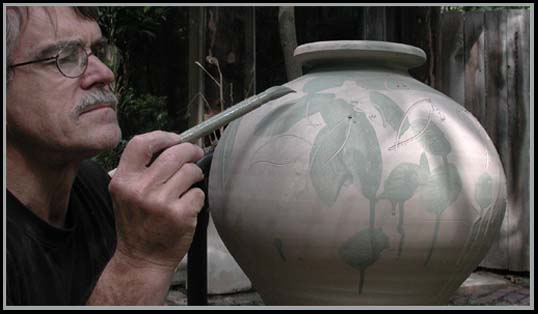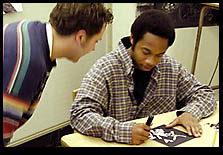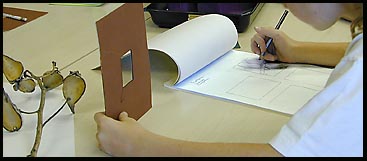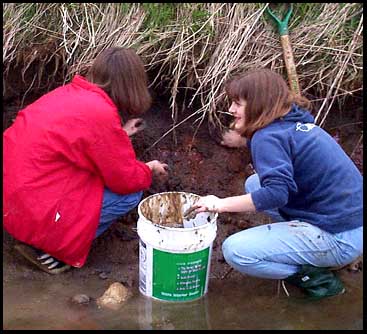How do students learn critical thinking? How can creative thinking be taught or learned? How can students be engaged in their own learning? How do some students become better at forming their own questions? TEACHING CREATIVITY USING OPEN QUESTIONS DIFFICULTY LEVEL MY OWN DISCOVERY WHY DO WE INQUIRE As learners, we have instinctive "monkey see monkey do" mirror neurons in our brains. However, we also have an opposite, but essential survival instinct. Learners who have lost their instinct to be skeptical and to imagine multiple scenarios are a threat to themselves and to our basic precepts of democracy and freedom. We have to question, to wonder, to experiment, be curious, love discovery, enjoy new experience, and tolerate ambiguities to remain free and creative. Teaching for a test that merely verifies a set of predetermined knowledge and standards is bound to be a very stilted self-defeating education because it deceives the learner into believing that they are successful if they learn to conform to others' wishes and answers. To become a creative contributor to society, I have to learn to wonder if their is a better answer to a better question. Our teaching and learning has to include skills in asking open questions. How can my testing be changed so that it asks students to add their own best questions, even if these questions call into question my assumptions of truth? Life-long learning does not happen unless I have learned how much want to learn that I do not yet know. The major problems in the world may not be solved by using only old solutions. Beginning with open questions How does a class respond differently when I begin with some open questions about a topic to learn? Can I activate a different part of students' brains with questions than with announcements of intention? Will students be more or less apt to pay attention when they expect to be called on or when they are told to pay attention? Why do they seem to be unwilling to share an opinion? Is their something about how they I respond? Is there something about their socialization with their peers that keeps them from thinking and responding creatively in class setting? When should I allow written responses and respect their privacy? How do I promote a culture of affirmative, emphatic, and active questioning and thinking out loud in my classroom? How would students' minds be affected if I invited and gave extra credit to alternative problem solving methods during my opening pop quiz that I use to check to see if assigned reading has been competed? How would their homework study habits change if I gave double credit when they proposed alternatives to what the authors in assigned reading had suggested? For example, the reading assignment may have been the historical account of the Boston Tea Party. What if students were given double credit for describing a viable alternative response to solve the problem of taxation without representation? What would happen if I began every class with a few provocative questions about the topic being studied? Might my students minds be influenced to imitate my inquiry methods? Posting thinking questions We can spend a lot of time with one or a few students while the remainder of the class is not involved. Noticing ceases when curiosity dies. Teachers who consciously try to teach creative thinking will soon realize the value of asking the right kind of open-ended questions. By posting good questions at strategic locations in the classroom, a virtual cafeteria of thoughts can motivate thinking and awareness. Posted questions that open up new approaches can be changed as needs, topics, abilities, and interests change. I have often found that when one student is stuck or experiencing a block, others may also be having similar problems. Awareness is one of essential components of creative inspiration and problem solving. If the motivational and inspirational questions are posted, I may be more efficient by reminding students to check the posted questions for inspiration. Question difficulty Teachers all know that difficulty level is a key factor in good motivation. When we see frustration, it is too hard. When we see boredom, it is too easy or resignation because of difficulty. When we ask a stupid question with a self-evident answer, students feel we are wasting time. Sometimes we need to ask redundant questions to remind kids of discipline issues or to reinforce some idea, but we need to realize that redundancy risks being dismissed as irrelevant. When posting questions we can vary the difficulty. When making lists, we can begin with some easier questions and end with some questions that would challenge the teacher. Verbal spontaneous questions can be tailored to the student. We inspire learning when we manage to make the hard stuff easier and the easy stuff challenging. I need to remember that art of teaching creative thinking is not to profess the known, but to inspire curiosity and thinking by teasing out new thinking with unexpected questions. Responding to STUDENT QUESTIONS Student questions often present teachable moments that catch us off guard. We tend to develop habits of response. It is amazing to me how variable different art teachers are in this regard. I was observing a student teacher who was teaching a painting lesson to a first grade class. I child asked, "How do I make pink?" Without a moment of reflection the student teacher said, "Put a little red in some white." This was a correct answer, but the wrong way to respond. I admit to doing it often, but regretting that I did it. This child was not taught how to imagine, hypothesize, and experiment. This first grader was encouraged on the unfortunate path to "learned helplessness." At least we can ask the child to make a guess, and then do a quick experiment. If the child finds that the guess is wrong, could we affirm the child for learning how to experiment, but then ask for another idea to try? When a child experiments and gets an unexpected result, it is especially important to give affirmation and explain that we are affirming the courage to take a chance of learning from a mistake. I recently heard Sara Blakely, a very successful young women explain how she had learned to think creatively. Her invention had made her wealthy. In explaining her own creativity and success, she explained that "Her father used to ask a weekly question of his children: What did you fail at this week? He was almost disappointed if they didn't have an answer. She was not afraid to fail." Do I satisfy my EGO or my student's brain? The derivative of the word "Educate" means to draw out A part of the brain that was alive and well two years earlier, before the child started formal education, is once again being vitalized with new neurons. If we refrain from giving answers, and teach children how to question, they soon learn to exercise their imaginations and ask these kinds of questions of their own minds. In time and with practice they become skilled in creative thinking, setting up their own experiments, and enjoying independent learning again. Even the creative habits of imagining, experimenting, questioning, and considering various options are learned by imitation. Good teaching provides good models to imitate. When teachers and parents model good questioning they nurture students that become habitually good questioners. It becomes part of their personalities. When teachers and parents give quick answers and dogmatic solutions they model minds that jump to unconsidered and unverified conclusions. Frequently this leads to bad choices, not only in mixing pink, but in many off color behavioral scenarios as well. Does our "quick easy answer" habits of teaching have something to do with why so many people in today's world believe the quick and easy catch phases of talk radio personalities and political campaign ads? Might this be encouraging thinking habits that buy into all kinds of conspiracy theories about what causes bad things to happen in the world? Changing habits of teaching The Hawthorne Effect may produce bad research, but the change it produces is real and can be very beneficial. My students, by being involved in the study, became more aware of thier own habits. MY SECRET RESEARCH ASSIGNMENT: HOW Do Teachers RESPOND TO STUDENT QUESTIONS? HOW TO CHANGE EDUCATION I needed a better way to make apprentice teachers more aware of learning and teaching styles that we discuss in theory class. I decided that they first needed to learn to notice and become aware of other methods. I had them do Secret Tally observation research. Now whenever they observe in an art class they are assigned to unobtrusively do research by keeping a secret TALLY of how the art teacher responds to student questions and requests for assistance. Many teachers tend to be art experts and answer nearly every question in a fairly knowing way. However, some teachers ask the student an open question that reassures the questioning student that the artwork is based on the student's choices. Still other teachers are especially good at getting students to experiment to find their own solutions. Some teachers use all of these approaches, depending on the situation and on how busy they were. It is neither my intention nor my goal to change the teachers that are being observed. I have made a few attempts at this, but who am I to ask experienced teachers to change what is working fine for them? I have my students do this tally, not because I expect to change what the teachers are doing, but because I find that this SPY MISSION ASSIGNMENT is an effective way to get prospective teachers to rethink their own roles as educators--not just people who pass on expert facts and art skills. Maybe education really is to draw out rather then to pour in. This assignment is a way to get them to think about why these teachers do what they do. We all tend to teach in the same ways we were taught. This is a way to try to change this. It challenges them to rethink what they experienced as students. These students become student teachers the following fall. In some cases student teachers still revert to the habit of being an expert who wants to answer every student question. After a visit to one such student teacher, I asked her what she remembered about the previous year when she had kept a tally of the teacher she was observing. Two weeks later, at my second visit, she had completely retrained herself and was doing a beautiful job of fostering creative thinking. Even though this college student had studied uncreative and creative coaching of students who asked for advise, when she started teaching, she automatically reverted to the way her teachers had taught her. Fortunately when asked if she remembered our study of teacher response to student questions, she was became aware of her own automatic habits and found ways to modify her own teaching habits. Transfer of learning is not automatic, but requires considerable nurture, coaching, and encouragement before it become habitual. TEST questions THAT TEACH CREATIVE THINKING Many teachers and testing companies assume that tests, in order to be scored reliably, have to ask questions with only one correct answer. Not so. Of course essay tests can ask open questions, but they require more time to read and evaluate. Computer scoring is difficult. What if our tests would be written to expect multiple correct answers? What if we gave more credit for those who answered with the most innovative and unique correct answers? What if our tests would ask for the opposites of the correct answers? How would education change if we tested in ways that draw out many and original answers rather then certain single expected answers? Also see: Writing tests for art class and tests to foster learning how to think better. EXAMPLE QUESTIONS These examples are only a start. No yes/no questions are used. There are no questions in these examples that have only one correct answer. |
|||||||||
|---|---|---|---|---|---|---|---|---|---|
Daniel H. Pink laments that schools are reducing the arts in favor of answer-giving for the test. He is definitely raising some good questions about questions. Recently, I saw a video (http://www.design-ed.org/video) where Pink talks about this. Pink says, ". . routines and right answers don't cut it anymore in the economy. . Jobs today are about novelty and nuances . . but our schools are still obsessed with routines and right answers . . So our schools in many ways are fighting the last war. ." He says the current emphasis on teaching for tests while cutting programs in the arts is making things worse. How questions change planning of courses, units, and lessons As students learn studio art, they are learning the questions and searching for the alternative and comparative answers. While a course in art is bound to provide some knowledge and tentative answers, the real way to assess the success of a studio art class may be the extent to which students are able to phrase their own better questions at the end of the course than they could at the outset of the course. If there was a written final exam in a studio art class, part of it could ask the students to write a list the most important questions that inspire them to continue learning art. These would be questions they would not have written had the test been given earlier as a pretest. Those with the fewest or least important new questions might get the lowest grades (if grades were assigned) because they are least apt to have learned to think like artists. They are least apt to continue their learning after the course is over. The students who continue to search and practice after the course is over represent the greatest success to an art teacher. Those who have learned that art is a search to answer ever more difficult and evocative questions have come to terms with the meaning of art and its purposes. If the ability to form good questions was part of the final exam, how would this assessment inform the planning of the course, the units, the projects, and the lessons? In what ways could questions become more central to the rituals and strategies used in teaching and learning? photo © 2001, Marvin Bartel
The following portion about the use of questions is taken from "Teaching Creativity" Answering questions
with questions Art and science have many commonalities, but the one I often fail to use is probably the most basic and important of all - the scientific method. The scientific method says that questions must be answered experimentally and the results are repeatable. Art students have often asked me to give them a suggestion to improve a work in progress. Many times my ego and my pompous personality have simply prompted me to blurt out an answer. I have given my recommendation without even thinking that this might have been a teachable moment. Had I been thinking scientifically, I might have coached the student to set up a small experiment, to make a comparison, and select an effective alternative. I may tell myself that my answer to the student question has taught the student something about art, about composition or about a media technique. Yes, there are many admirable goals and standards that students need to learn. Therefore, my questions and the student experiments need be designed to foster discovery and understanding about art content. I may tell myself that it is much faster to just make the suggestions than it is for the student to "reinvent the wheel" when learning all these standard concepts about art. On the other hand, I need to wonder how strongly a student will believe in something, or how long a student will remember something that comes from the teacher compared to something that is discovered by the student. How often does a teachers have to repeat a suggestion or a rule? Compare this to how often a student needs to make a discovery before it becomes believed and practiced by the student. If art teachers are there to give answers, who in the school is there to teach the ability to ask good questions? One of my most gratifying teaching events was a time when I was working with a preschool girl. While she was drawing, I continued to ask her questions about her drawing and she continued to answer my questions by drawing more content. She soon began to ask questions of herself as she was drawing. Her drawings became amazingly complex with all kinds of content that had never previously been included. Older students do not speak the questions aloud, but I am convinced that they also learn to do self-questioning when good questioning is modeled for them by teachers and parents. Teaching habits are powerful and subtle. Answering questions in the studio class gives me such a feeling of power and is such a hard habit to break. As an artist, I am generally more clever than the student - what an ego trip! During the Dark Ages science was a set of teacher answers. Progress began when the scientific method began using questions and experiments to check on old answers and discover new answers. In science, nothing is assumed to be true because a teacher says so. Too often my art class was taught using Dark Ages dogmatism.
Some teachers feel that the visual elements and the principles of design are the basic structure of art. It is thought that if we teach the basic structure, art will happen. That was a modern art idea developed during the 1930's. Hmm? I'm sorry, but art has turned out to be a bit messier. The elements and principles are often useful. However, they can be too limiting and if they are understood too simplistically. The visual elements and the principles fail to acknowledge content, symbol, meaning, and untraditional ways of being artistic. As long there are imaginative and creative artists, we will keep seeing new scenarios in art that are based on new situations and experiences. Every artwork is different and there is no simple system that covers everything not yet imagined. If there are any final equations, computer programs, verbal pronouncements, or whatever, that give a final definition of art; we will have witnessed the final implosion of truth, beauty, and the human imagination. In the meantime, there is little harm in working at definitions and tentative rules so long as we also agree to live with uncertainty and change. As in life, if there are rules, they are more likely to be things like: pay attention, make comparisons, look before you leap, and so on. They can guide, but not determine the process, and they certainly do not determine art products and the outcomes. TIME for the CREATIVE PROCESS - HOMEWORK for the MIND? In organizing the sequence of lessons, are there ways to ritualize advance preparation, discussions, questions, practice sessions, and sketching sessions that promote thinking, looking, more sketching, dreaming, and idea development for lessons that are coming in the future. Are there ways to encourage and reward the keeping track of art ideas that come to mind at When I leave my studio my hands-on work is interrupted, but my mind keeps working - this is when my homework starts. When students leave class, are there ways to engage the mind so this habitual homework of the subconscious mind has been assigned? The creative process includes preparation, incubation, insight, elaboration, and evaluation. Classrooms that include preparation, incubation, and insight might need to juggle several projects at once. What are the class rituals and concept questions that get the wheels turning so that dreams and imaginations are ignited? I have often been tempted to use shortcuts such as showing examples of other art to get quick inspiration and information as a substitute for relevant self-referential thinking. But what are the ways to define artistic challenges in ways that to give the students the courage to develop and express their own ideas? This takes time. It means practice sessions, question sessions, and list making rituals. This means setting aside time days or weeks in advance of the actual production to get students It means programming their minds to do the subconscious incubation homework that helps bring insight to the table when the production starts. We know that homework works best when we develop rituals of accountability and when we make a point of rewarding successes. What are our classroom rituals that give credit and honor to the students when they show evidence of subliminal ideas that have been recorded and brought to class and infused in their creative work? My own creativity in art, in teaching, and in life is constantly being fostered by my curiousity and new questions that present themselves each time I make a new discovery. As I gain a new insight, serveral new questions also reveal themselves.
The author
invites your
comments and questions. Contact
the author END OF ARTICLE Hetland, L., Winner, E., Veenema, S., &
Sheridan, K. M. (2007) Studio Thinking:
The real benefits of visual arts education. New York: Teachers College
Press, Columbia U.
Pink, D. H. (2009) Drive: the surprising truth about what motivates us. Penquin Group, New York Pink, D. H. Design-Ed for Students website http://www.design-ed.org/video (retrieved January 11, 2013)
back to top of article SOME LINKS YOU MIGHT LIKE This is an offsite link from the Scribd.com website. It is a list of writing prompts about art. Many of these are questions. The ideas could also be changed into open-ended questions to use in a class discussion or as project motivation during studio classes.
back to top
of article
|



